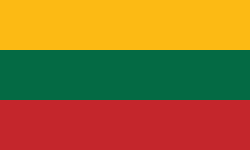Šeduva
 |
Šeduva was an agricultural town dealing in cereals, flax and linseed, pigs and geese and horses, at the site of a royal estate and beside a road from Kaunas to Riga. The population from the fifteenth century was Catholic and Jewish. Until then, Lithuania had been the last pagan kingdom in Europe and allowed freedom of worship and toleration of Jews and other religions. The first Catholic shrine of Šeduva, the Church of the Invention of the Holy Cross, was built and the parish founded between 1512 and 1529. The present brick church Cross was built in Šeduva in 1643 with a donation from bishop Jurgis Tiškevičius of Vilnius. During the 18th century the bell tower was added to the structure, with further renovations and extensions in 1905. Baroque and renaissance architectural styles characterise both the exterior and interior of the church. It has a cruciform plan with an apse, low sacristy and five altars.
During the 15th century the region was redefined as the Voivodeship of Trakai and Vilnius. Later it became part of the Grand Duchy of Lithuania until the Union of Lublin in 1569 created the Polish-Lithuanian Commonwealth.
The Šeduva coat of arms were granted on June 25, 1654 by John II Casimir Vasa, King of Poland and Grand Duke of Lithuania and at the same time the city was granted burger rights at the request of Maria Ludvika, Queen of Poland. She descended from the Princes of Gonzaga, from Mantua in Italy. The arms of the family showed a black eagle. The small breastshield shows the French fleur-de-lis, because the Gonzaga family was related to the French Royal family. The eagle was made white in reference to the white eagle of Poland. 1792 Stanislaw II August Poniatowski, the last royal proprietor of Šeduva, concluded an agreement with the town's citizens, giving them rights to be excused from labour on the estate for a fee. In 1795, the year of a terrible fire in Šeduva, Lithuania became part of Russia when Poland was partitioned. From 1798, Baron Theodore von Ropp did not acknowledge the rights of Šeduva citizens and required of the citizens to perform labour in the town's manor. The citizens petitioned for their rights to the Russian Senate. In 1812, the Senate passed the decision to recognise the former charters of Šeduva.
Between 1696 and 1762, a Jesuit mission, connected with their college at Pašiaušė, was active in the town, operating a lower school with 96 pupils up until 1828. After an insurrection in 1863 (the January Uprising), all parish schools in Šeduva were closed and replaced by public Russian language schools. In the same year a Russian Orthodox Church, designed by the architect Ustinas Golinevicius, was built and in 1866 a wooden Synagogue was added near the central market square.
The Molotov-Ribbentrop Pact between Nazi Germany and Communist Russia in August 1939 and the German-Soviet Boundary and Friendship Treaty a month later placed Lithuania under Soviet control. By June 1940 the Soviets had set up a pro-Soviet government and stationed many Red Army troops in Lithuania as part of the Mutual Assistance Pact between the countries. President Antanas Smetona was forced to leave as 15 Red Army divisions came in.
The pro-Soviet puppet government was controlled by Vladimir Dekanozov and Justas Paleckis, and Lithuania was made part of the Soviet Union. A Sovietisation programme began immediately. Land, banks and large businesses were nationalised. All religious, cultural, and political organizations were abolished except the Communist party. 17,000 people were deported to Siberia, where many would perish.
During the years of Lithuanian anti-Soviet partisan resistance (1944–1953) in Šeduva and neighbouring districts Lithuanian Žalioji rinktinė (The Green Squad), belonging to partisans' Algimantas military district was active.
Šeduva is famous for sheep farming, Lithuanian Black-headed sheep are grown. The state enterprise Šeduvos avininkystė is responsible for the preservation of the genetic stock of Lithuanian Black-Headed sheep.
Map - Šeduva
Map
Country - Lithuanian_Soviet_Socialist_Republic_(1918–1919)
 |
 |
| Flag of Lithuania | |
Germany had lost World War I and signed the Compiègne Armistice on 11 November 1918. Its military forces then started retreating from the former Ober Ost territories. Two days later, the government of the Soviet Russia renounced the Treaty of Brest-Litovsk, which had assured Lithuania's independence. Soviet forces then launched a westward offensive against Estonia, Latvia, Lithuania, Poland and Ukraine in an effort to spread the global proletarian revolution and replace national independence movements with Soviet republics. Their forces followed retreating German troops and reached Lithuania by the end of December 1918.
Currency / Language
| ISO | Currency | Symbol | Significant figures |
|---|---|---|---|
| EUR | Euro | € | 2 |
| ISO | Language |
|---|---|
| LT | Lithuanian language |
| PL | Polish language |
| RU | Russian language |















